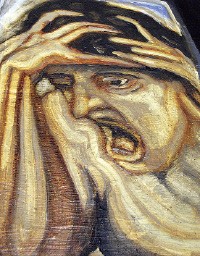For the last several years, Los Angeles-based photographer Theresa Kereakes has focused her lens on Memphis garage-rock icons such as Monsieur Jeffrey Evans, Jack Yarber, and Harlan T. Bobo, adding their images to her already vast musical pantheon.
Late last month, as part of a continental “tour” that includes stops in Atlanta, Toronto, Houston, and Oxford, Mississippi, Kereakes returned to Memphis — not to shoot more photos, but to begin installing an exhibit of her work, which goes on display at Goner Records Thursday, November 1st.
Titled “Punk Rock Day of the Dead,” there’s not a Memphis musician in the bunch. Instead, Kereakes — who showed past work here as part of 2005’s Gonerfest 2 — turns a critical eye on “live fast, die young” L.A. musicians such as Germs frontman Darby Crash, who died of a drug overdose in 1980; AIDS casualties such as Black Randy (who founded West Coast art-punk group Metrosquad) and Lance Loud; Jeffrey Lee Pierce, who died of a brain hemorrhage at 37; and former Cramps guitarist Bryan Gregory, who dropped dead of a heart attack four years before his 50th birthday.
“Out of all the people I have pictures of, the ones who really resonate are the dead guys,” admits Kereakes, who, during punk’s heyday, also captured legends like Johnny Thunders, who died under mysterious circumstances in New Orleans when he was just 38, and Stiv Bators, the cocksure Dead Boys vocalist who died in his sleep after being struck down by a Paris taxi.
“One time, Stiv painted ‘R.I.P. Sid Vicious’ on a billboard for the movie Heaven Can Wait,” she recalls. “He called me up and said, ‘You know, Sid’s died. You’ve got to come see this billboard on Sunset [Boulevard].’ I shot a picture of it, which was used as the lead picture for Creem magazine’s obituary of Sid.
“Later on, when Stiv was touring with Lords of the New Church for the last time, he’d become such a monster. He was doing every kind of speed imaginable, which turned him into the biggest jackass. I’d still drive him around and take him places, but I was angry at him. Then someone called me from Paris and said Stiv was dead. I said, ‘Put him on the phone — now,’ because he was someone who’d fake death two or three times a week. But they said that he was really dead.”
Today, Kereakes considers herself a survivor of a scene where “even the ones who weren’t drug addicts, alcoholics, or complete fuck-ups” are lucky to be alive.
“We’d drive all night to concerts. I remember doing a five-hour drive in the rain to San Francisco to see the Sex Pistols. I’ve lived fast and hard, and somebody’s been watching over me. It puts a lot of things in perspective,” she says.
“Back in the day, during the first punk rock gestalt, I think we had the right degree of narcissism. We knew we were special. We were gonna take over the world,” says Kereakes, whose ’70s-era portraits of the Cramps, Avengers vocalist Penelope Houston, and the Velvet Underground‘s John Cale appear in Punk 365, Holly George-Warren‘s coffee-table tome on the musical genre, published by Abrams this month as part of the 30th anniversary of a revolution that began with the October ’77 release of Never Mind the Bollocks, Here’s the Sex Pistols.
“I couldn’t do this show in my hometown,” Kereakes declares of “Punk Rock Day of the Dead.” “In L.A., there’d be so many expectations. They knew all of these people already, and there’s so much information people would bring to the party — too much ‘I don’t like that guy.’
“Memphis is different,” she says. “It’s more fun, because people really like the music, and there’s no judgment about the musicians. I find this town so warm and welcoming. I’m a huge Oblivians fan and to be able to walk into a place and find people like Jack, Eric [Friedl, founder of the Goner Records label], and Jeff Evans, and document what they do seems so important.”
Surveying her work, which includes a portrait of an uncharacteristically fragile-looking Darby Crash holding an acoustic guitar and an action shot of Stiv Bators sharing the spotlight with Dee Dee Ramone, Kereakes says of her numerous friends who have crossed over from notoriety to immortality, “Unfortunately, dead, they’re worth a whole lot more.”

